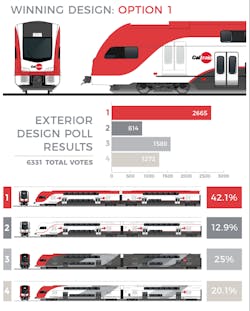Poll Shows Riders Preference on New High-Performance Electric Trains
In a recent survey, Caltrain asked riders for their opinion about what the exterior of the new high-performance electric trains should look like as part of the Peninsula Corridor Electrification Project, and the results are in.
Approximately 6,331 total votes were cast on the exterior design poll, which was open to the public from May 12-19. Of those votes, 42.1 percent of the participants chose Option 1, with Option 3 coming in second place, Option 4 coming in third, and Option 2 placing last. Option 1 was also the top choice among Caltrain staff.
In May, Caltrain launched the www.calmodtrains.com website to allow the public to provide input on the look and feel of the next generation of the system’s trains. Users of the website will learn about some of the new electric train features, including more plentiful electrical outlets, better location and destination information, increased system-wide capacity and the configuration of passenger and bike cars.
The new website will also allow the public to provide continued feedback on many design options over the next several months, including seat color and bike storage. And next year, after feedback on the design is complete, the site will feature a 360-degree virtual tour of the new trains.
On May 22, 2017, the Federal Transit Administration announced that they will execute a Full Funding Grant Agreement committing $647 million to the Electrification Project.
Caltrain has worked for over two decades to plan this critical improvement. Over the last few years, more than $1.3 billion was secured from local, regional and State commitments, and contracts were awarded to design, and eventually construct the project. This agreement commits the final funding needed to start construction of a project that will transform and improve the way people travel along one of the region’s most congested corridors.
Electrifying the system allows Caltrain to replace the current diesel locomotive fleet with high-performance trains that will increase the system’s overall capacity and will provide faster, more frequent, and more reliable service to communities between San Francisco and San Jose.
